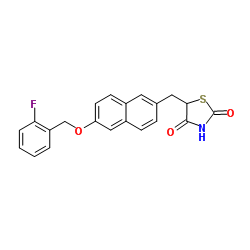Netoglitazone is a PPAR-gamma ligand with selective effects on bone and fat
Oxana P. Lazarenko, Sylwia O. Rzonca, Larry J. Suva, Beata Lecka-Czernik, Oxana P Lazarenko, Sylwia O Rzonca, Larry J Suva, Beata Lecka-Czernik
Index: Bone 38(1) , 74-84, (2006)
Full Text: HTML
Abstract
Thiazolidinediones are effective anti-diabetic drugs that improve insulin sensitivity through the activation of the nuclear receptor and adipocyte-specific transcription factor, peroxisome proliferator-activated receptor gamma (PPAR-γ). Recent evidence suggests that PPAR-γ also controls bone cell development and bone homeostasis. In mice, PPAR-γ insufficiency results in increased bone mass, whereas administration of the specific PPAR-γ agonist rosiglitazone leads to bone loss and increased bone marrow adiposity. Although the pro-adipocytic and anti-osteoblastic activities of PPAR-γ can be separated in vitro using ligands with distinct chemical structures, little evidence exists supporting this functional separation in vivo. Netoglitazone (MCC-555, RWJ-241947) is a thiazolidinedione, which acts as either a full or partial PPAR-γ agonist, or antagonist, in a cell type specific manner. In this study, the pro-adipocytic and anti-osteoblastic activities of netoglitazone were evaluated in vitro, using both U-33/γ2 cells as a model of marrow mesenchymal cell differentiation under the control of PPAR-γ2 and primary bone marrow cultures, and in vivo in C57BL/6 mice. In vitro, netoglitazone induced adipocyte and inhibited osteoblast formation in a PPAR-γ2-dependent manner; however, it was 100-fold less effective than rosiglitazone. In vivo, the administration of netoglitazone at an effective hyperglycemic dose (10 μg/g body weight/day) did not result in trabecular bone loss. Bone quality parameters such as bone mineral density and bone microarchitecture were not affected in netoglitazone-treated animals. The observed lack of an in vivo effect of netoglitazone on bone was entirely consistent with its low anti-osteoblastic activity in vitro. In contrast to the observed in vitro effects, netoglitazone in vivo effectively induced marrow adipocyte formation and induced changes in the weights of extramedullary fat depots. Consistent with these cell type-specific effects, expression of the adipocyte-specific gene marker FABP4/aP2 was increased, whereas the expression of osteoblast-specific gene markers, Runx2, Dlx5, osteocalcin, and collagen were not affected by netoglitazone. In conclusion, netoglitazone is a member of a new class of PPAR-γ ligands with distinct anti-diabetic, anti-osteoblastic, and pro-adipocytic activities in vivo.
Related Compounds
| Structure | Name/CAS No. | Molecular Formula | Articles |
|---|---|---|---|
 |
netoglitazone
CAS:161600-01-7 |
C21H16FNO3S |
|
MCC-555-induced NAG-1 expression is mediated in part by KLF4...
2010-07-10 [Eur. J. Pharmacol. 637(1-3) , 30-7, (2010)] |
|
Chronic treatment with the thiazolidinedione, MCC-555, is as...
2003-04-01 [Int. J. Exp. Pathol. 84(2) , 83-9, (2003)] |
|
Activation of PPARgamma is not involved in butyrate-induced ...
2005-10-15 [Exp. Cell Res. 310(1) , 196-204, (2005)] |
|
Quantitative determination of MCC-555, a novel insulin sensi...
2006-05-01 [J. Chromatogr. B. Analyt. Technol. Biomed. Life Sci. 835(1-2) , 35-9, (2006)] |
|
[KRP-297, MCC-555].
2001-11-01 [Nihon Rinsho. 59(11) , 2200-6, (2001)] |